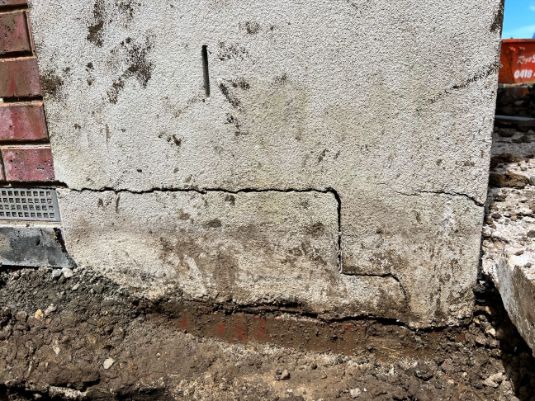Underpinning is a foundation repairs process used to reinforce the foundation of an existing structure where a slab or strip footing is used. This is done by extending the foundation to a deeper, more stable level to reduce and minimise foundational movement.
In this article, we’ll discuss what underpinning is, when you need it, and some different types of building foundations and footings.
When Is Underpinning Needed?
Underpinning is needed when repairing or strengthening a foundation that has been damaged. It is also necessary when you need to increase the structural support for a building. Most experts would recommend underpinning when another story is added to a building or a renovation is taking place.
You should consider underpinning your house if:
- It is built on reactive soils, and you’ve noticed movement
- The fill under your foundation is not compacted properly
- There is poor drainage around your foundation
- You are planning to extend or renovate your house
- You have cracks in your walls and floors
- Your doors and windows are not closing correctly
If you see all or most of the above happening, you need to contact a local contractor who works on repairing foundations.

Types of Building Foundations and Footings
The different types of building foundations and footings are:
Slab on Ground
This is the most common type of foundation. It’s a concrete slab poured directly onto the ground. The soil underneath the slab must be compacted to provide a stable base. If the soil is not compacted correctly, it can settle over time and cause the foundation to crack or collapse.
Suspended Floors
Unlike a traditional floor, a suspended floor is not laid on the ground. Instead, it is connected to the ground by stumps or piers.
Continuous Footings
Continuous footings are used to support loads that are distributed evenly. They can be concrete strips or slabs. They are commonly used to support walls built on sloping sites.
Pad Footings
Pad footings are used to support loads that are not evenly distributed. They are usually concrete pads or piers that are commonly used to support columns, posts, and stairs.
Stumps
Stumps are posts that support a house’s subfloor and are concreted into the ground. They’re commonly made of reinforced concrete but can also be steel or timber.
Piles
Piles are long, vertical steel or concrete sections that are driven into the ground. Piles are used to strengthen the foundation where the soil is not sturdy enough to support the weight of the house. Piles are usually used with a pad footing or a strip footing.
Piers
Piers are vertical structures that support a building’s beams. They are made from steel or concrete. Once the piers are set into the dug holes, it is reinforced with concrete to stay in place.

Why Do Building Foundations Fail?
Building foundations fail because of the following reasons:
Reactive Soils
Reactive soils are soils that expand and contract in response to changes in moisture content. This can cause the soil to heave or settle, damaging the foundation.
Poorly Compacted Fill
Suppose the fill under the foundation is not compacted correctly. In that case, it can settle over time and cause the foundation to crack or collapse.
Site Erosion
Erosion can also damage a foundation. When water washes away soil from around the foundation, it can leave the foundation unsupported and susceptible to damage.
What Are the Main Benefits of Underpinning?
The main benefits of underpinning are:
- Enhanced Structural Integrity
- Increased Property Value
- Improved Ceiling Height and Lighting
Which Underpinning Method is Best for Me?
The best underpinning method for you is the one recommended by an experienced foundation repair contractor. This professional will inspect the surrounding, foundation, and footing of your house to identify the problem.
After that, they will brief you on what to do and the estimated cost and time. We have written a blog to give you an idea about the cost of underpinning, read this blog to get a clear picture.
Also, if you want to know more about underpinning, we have a blog explaining, “Does My Home Need Underpinning?“. You should check this out.
